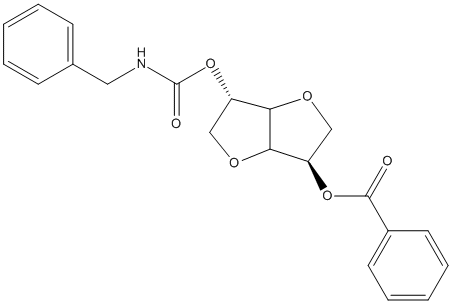Isosorbide-2-benzylcarbamate-5-benzoate
IC(50) of 4.3 nM for human plasma butyrylcholinesterase, but 1.09 microM for mouse plasma butyrylcholinesterase
General
Type : Isosorbide,Carbamate,Benzoate
Chemical_Nomenclature : [(3R,3aR,6S,6aR)-6-(benzylcarbamoyloxy)-2,3,3a,5,6,6a-hexahydrofuro[3,2-b]furan-3-yl] benzoate
Canonical SMILES : C1C(C2C(O1)C(CO2)OC(=O)NCC3=CC=CC=C3)OC(=O)C4=CC=CC=C4
InChI : InChI=1S\/C21H21NO6\/c23-20(15-9-5-2-6-10-15)27-16-12-25-19-17(13-26-18(16)19)28-21(24)22-11-14-7-3-1-4-8-14\/h1-10,16-19H,11-13H2,(H,22,24)\/t16-,17+,18-,19-\/m1\/s1
InChIKey : NIWDLVRLOCHGOV-FCGDIQPGSA-N
Other name(s) : CHEMBL523830,Isosorbide-2-(benzylcarbamate)-5-benzoate,D0LL8H,BDBM50253231,(3R,3aR,6S,6aR)-6-(benzylcarbamoyloxy)hexahydrofuro[3,2-b]furan-3-yl benzoate
MW : 383.4
Formula : C21H21NO6
CAS_number :
PubChem : 25129141
UniChem : NIWDLVRLOCHGOV-FCGDIQPGSA-N
IUPHAR :
Wikipedia :

Target
Families : Isosorbide-2-benzylcarbamate-5-benzoate ligand of proteins in family: BCHE
Stucture :
Protein : human-BCHE
References (2)
| Title : Isosorbide-2-benzyl carbamate-5-salicylate, a peripheral anionic site binding subnanomolar selective butyrylcholinesterase inhibitor - Carolan_2010_J.Med.Chem_53_1190 |
| Author(s) : Carolan CG , Dillon GP , Khan D , Ryder SA , Gaynor JM , Reidy S , Marquez JF , Jones M , Holland V , Gilmer JF |
| Ref : Journal of Medicinal Chemistry , 53 :1190 , 2010 |
| Abstract : Carolan_2010_J.Med.Chem_53_1190 |
| ESTHER : Carolan_2010_J.Med.Chem_53_1190 |
| PubMedSearch : Carolan_2010_J.Med.Chem_53_1190 |
| PubMedID: 20067290 |
| Title : Pharmacological effects of a novel isosorbide-based butyrylcholinesterase inhibitor - Khan_2008_Chem.Biol.Interact_175_231 |
| Author(s) : Khan D , Gilmer JF , Carolan CG , Gaynor JM , Ryder SA |
| Ref : Chemico-Biological Interactions , 175 :231 , 2008 |
| Abstract : Khan_2008_Chem.Biol.Interact_175_231 |
| ESTHER : Khan_2008_Chem.Biol.Interact_175_231 |
| PubMedSearch : Khan_2008_Chem.Biol.Interact_175_231 |
| PubMedID: 18606399 |